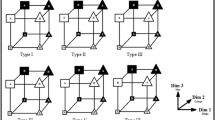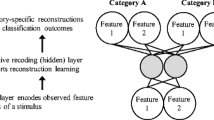Abstract
We consider two models of unsupervised categorization, the simplicity model and the rational model. Their comparison is interesting because the models are based on proximal mathematical principles (minimum description length and Bayesian inference), but their implementation is very different (the simplicity model prefers groupings of similar items, while the rational model groupings which have higher utility). The models’ predictions were assessed with a series of artificial datasets, such that each dataset was designed to reflect a simple intuition about human categorization processes. In the case of linearly separable categories, such that each category was composed of two subgroups, and in the case of non-linearly separable categories, the predictions of the simplicity model and rational diverged. Implications for future developments in unsupervised categorization are discussed.
Similar content being viewed by others
References
Anderson JR (1991) The adaptive nature of human categorization. Psychol Rev 98: 409–429
Anderson JR, Matessa M (1992) Explorations of an incremental, Bayesian algorithm for categorization. Mach Learn 9: 275–308
Ashby FG, Queller S, Berretty PM (1999) On the dominance of unidimensional rules in unsupervised categorization. Percept Psychophys 61: 1178–1199
Blair M, Homa D (2001) Expanding the search for a linear separability constraint on category learning. Mem Cognit 29: 1153–1164
Chater N (1996) Reconciling simplicity and likelihood principles in perceptual organization. Psychol Rev 103: 566–591
Chater N (1999) The search for simplicity: a fundamental cognitive principle. Q J Exp Psychol 52: 273–302
Compton BJ, Logan GD (1993) Evaluating a computational model of perceptual grouping. Percept Psychophys 53: 403–421
Compton BJ, Logan GD (1999) Judgments of perceptual groups: reliability and sensitivity to stimulus transformation. Percept Psychophys 61: 1320–1335
Corter JE, Gluck MA (1992) Explaining basic categories: feature predictability and information. Psychol Bull 2: 291–303
Feldman J (2000) Minimization of Boolean complexity in human concept learning. Nature 407: 630–633
Garner WR (1974) The processing of information and structure. LEA, Potomac, Md
Hahn U, Chater N (1998) Similarity and rules: distinct? exhaustive? empirically distinguishable?. Cognition 65: 197–230
Hines P, Pothos EM, Chater N (2007) A non-parametric approach to simplicity clustering. Appl Artif Intell 21: 729–752
Hochberg JE, McAlister E (1953) A quantitative approach to figural goodness. J Exp Psychol 46: 361–364
Jones GV (1983) Identifying basic categories. Psychol Bull 94: 423–428
Komatsu LK (1992) Recent views of conceptual structure. Psychol Bull 112: 500–526
Krzanowski WJ, Marriott FHC (1995) Multivariate analysis, part 2: classification, covariance structures and repeated measurements. Arnold, London
Lewandowsky S, Roberts L, Yang L (2006) Knowledge partitioning in categorization: boundary conditions. Mem Cognit 34: 1676–1688
Li M, Vitányi P (1997) An introduction to Kolmogorov complexity and its applications (2nd Edition). Springer-Verlag, New York
Love BC, Medin DL, Gureckis TM (2004) SUSTAIN: a network model of category learning. Psychol Rev 111: 309–332
Mareschal D, French RM, Quinn P (2000) A connectionist account of asymmetric category learning in infancy. Dev Psychol 36: 635–645
Medin DL (1983) Structural principles of categorization. In: Shepp B, Tighe T (eds) Interaction: perception, development and cognition. Erlbaum, Hillsdale, NJ, pp 203–230
Medin DL, Schwanenflugel PJ (1981) Linear separability in classification learning. J Exp Psychol [Hum Learn] 75: 355–368
Milton F, Wills AJ (2004) The influence of stimulus properties on category construction. J Exp Psychol Learn Mem Cogn 30: 407–415
Milton FN, Longmore CA, Wills AJ (2009) Processes of overall similarity sorting in free classification. J Exp Psychol Hum Percept Perform 34(3): 676–692
Murphy GL (1982) Cue validity and levels of categorization. Psychol Bull 91: 174–177
Nosofsky RM (1989) Further tests of an exemplar-similarity approach to relating identification and categorization. J Exp Psychol Percept Psychophys 45: 279–290
Nosofsky RM (1990) Relations between exemplar-similarity and likelihood models of classification. J Math Psychol 34: 393–418
Nosofsky RM (1992) Similarity scaling and cognitive process models. Annu Rev Psychol 43: 25–53
Nosofsky RM, Zaki SR (2002) Exemplar and prototype models revisited: response strategies, selective attention, and stimulus generalization. J Exp Psychol Learn Mem Cogn 30: 936–941
Oaksford M, Chater N (1994) A rational analysis of the selection task as optimal data selection. Psychol Rev 101: 608–631
Pothos EM (2005) The rules versus similarity distinction. Behav Brain Sci 28: 1–49
Pothos EM, Chater N (2002) A simplicity principle in unsupervised human categorization. Cogn Sci 26: 303–343
Pothos EM, Chater N (2005) Unsupervised categorization and category learning. Q J Exp Psychol 58A: 733–752
Pothos EM, Wolff JG (2006) The simplicity and power model for inductive inference. Artif Intell Rev 26: 211–225
Pothos EM, Close J (2008) One or two dimensions in spontaneous classification: a simplicity approach. Cognition 107: 581–602
Rissanen J (1978) Modeling by shortest data description. Automatica 14: 465–471
Rosch E, Mervis CB (1975) Family resemblances: studies in the internal structure of categories. Cogn Psychol 7: 573–605
Ruts W, Storms G, Hampton JA (2004) Linear separability in superordinate natural language concepts. Mem Cognit 32: 83–95
Sanborn AN, Griffiths TL, Navarro D (2006) A more rational model of categorization. In: Sun R, Miyake N (eds) Proceedings of the 28th Annual Conference of the Cognitive Science Society. Erlbaum, Mahwah, NJ
Schyns PG (1991) A modular neural network model of concept acquisition. Cogn Sci 15: 461–508
Shepard RN (1987) Toward a universal law of generalization for psychological science. Science 237: 1317–1323
Smith JD, Murray MJ Jr, Minda JP (1997) Straight talk about linear separability. J Exp Psychol Learn Mem Cogn 23: 659–680
Solomonoff RJ (1964) A formal theory of inductive inference. Parts I and II. Inform Control 7: 1–22, 224–254.
Stewart N, Chater N (2002) The effect of category variability in perceptual categorization. J Exp Psychol Learn Mem Cogn 28: 893–907
Tenenbaum J, Griffiths TL (2001) Generalization, similarity, and Bayesian inference. Behav Brain Sci 24: 629–641
Tenenbaum JB, Griffiths TL, Kemp C (2006) Theory-based Bayesian models of inductive learning and reasoning. Trends Cogn Sci 10: 309–318
Tversky A (1977) Features of similarity. Psychol Rev 84: 327–352
Wattenmaker WD (1995) Knowledge structures and linear separability: integrating information in object and social categorization. Cogn Psychol 28: 274–328
Wolff JG (2003) Information compression by multiple alignment, unification and search as a unifying principle in computing and cognition. Artif Intell Rev 19(3): 193–230
Author information
Authors and Affiliations
Corresponding author
Rights and permissions
About this article
Cite this article
Pothos, E.M. Occam and Bayes in predicting category intuitiveness. Artif Intell Rev 28, 257–274 (2007). https://doi.org/10.1007/s10462-009-9102-0
Received:
Accepted:
Published:
Issue Date:
DOI: https://doi.org/10.1007/s10462-009-9102-0




